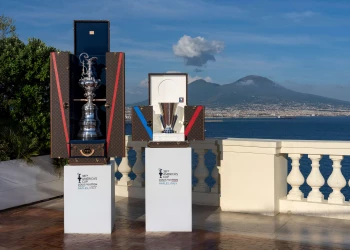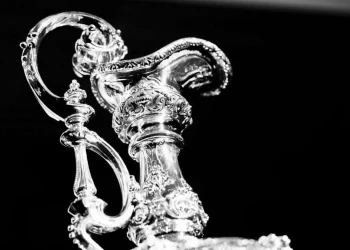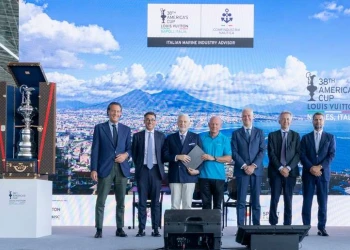
America's Cup: different conditions whipped in on the Levant
America's Cup: different conditions whipped in on the Levant
Just as all the Challenger teams of the Louis Vuitton 37th America’s Cup were getting used to glorious southerly ‘Garbi’ winds, suddenly Barcelona throws in a curve-ball with a solid easterly, the famous 'Levant,' packing a very nasty short chop of 3 second period, kicking up wave heights of up to 1.6 metres as recorded by the recon teams. Chase Boats were not for the faint of heart, this was a tough day but one that the sailors revelled in.
Four AC75s were on the water today at various times with Luna Rossa Prada Pirelli leading the charge out of the harbour before midday and putting in a shift of over four hours, really dialling into the pre-start manoeuvres. This was the Italians putting the pedal to the floor and mimicking the kind of intensity that we saw in Cagliari in their LEQ12. A total of six pre-starts in rapid succession after some full-on upwind/downwind work to get acclimatised to the rare easterly conditions, really saw Luna Rossa working up to race pace with very impressive boat handling and co-ordination.
Speaking afterwards, Andrea Tesei, the stand-out Trimmer and Flight Controller for the Italian team now in his second Cup campaign, summed up the tricky conditions saying: “Today was definitely new conditions that we didn't encounter in the past weeks. We had a bit of waves on Saturday but was still coming from the south-west, for longer periods today we got the famous Levante again which we encountered last year, and it was as we remembered, very tough, pretty gusty, lots of wind lulls, and gusts coming in and the very steep and short chop - especially getting close to the shore with lighter breeze so a lot to work on technique and handling in this condition.”
The recon team noted aggressive cant angling from Luna Rossa today as the Flight Controller trod the fine line between height and speed with Andrea confirming, saying: “You’re always playing with the canting angle, I like to make the comparison to a trapeze harness in a skiff or another boat so depending on the situation and your angle to the waves we need to adapt the trim of the cant angle, so it’s pretty dynamic depending on shifts and wind breeze.”
Another observation was how little the Italians trimmed the traveller on the mainsail, again with Andrea confirming as such: “At the end of the day in this boat, you want to move the less you can not to trigger a snowball, the less you move the easier it becomes obviously to find the right track to make it happen so it's not that easy, so not really looking into moving less the traveller we were just trying to fix the boat in these waves and finding a stable flight and a stable trim.”
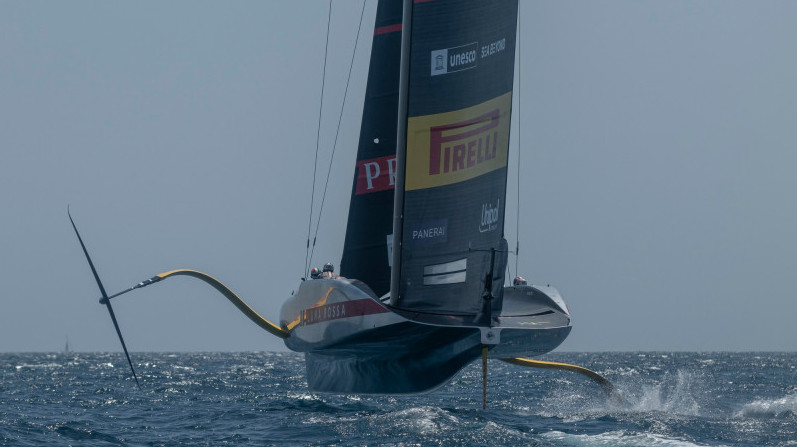
It was a tough day for the cyclors but Andrea was more than happy with what was delivered: “I mean the guys are pushing hard on the bikes, we definitely have more power than the past Cup with the cyclors and obviously the systems have been improving and we're pretty happy about our systems. Obviously, you never have enough. You always want more, and you can always improve in any in any department so even in the power you would want infinite power.” Now there’s a concept.
Great session from the Italians who are revelling here in Barcelona and looking better and better as they wind this boat up to race pace at an alarmingly fast rate. In these conditions, they look almost untouchable.
INEOS Britannia meanwhile looked to be quite a handful in the swell for Giles Scott and Ben Ainslie, particularly downwind, with the Flight Controllers really playing the heights through the waves and trying their best to keep it at the optimum. The bustle profile and the bulbous bow section were working hard, but for the first time we saw quite a twitchy Britannia.
A semi-line-up with Luna Rossa was quite revealing with the Italians looking to achieve a much more stable platform whilst the British seemed to fight the boat – perhaps having the RO1 rudder back was a hinderance, but something was not quite ‘on’ today and a nosedive out of a gybe downwind brought that little exchange to a halt. A further exchange, later in the day with NYYC American Magic, saw the British hit a touchdown tack and again, that exchange ended quickly.
Leigh McMillan was observing from the team Chase Boat today and summed it up the conditions and the test of skill accurately, saying: “It was really lumpy out there, pretty unpleasant I’ve got to see the physio for the next few days I think after that, it’s a much smoother ride on the race boat, but it's interesting to see it from the chase boat and it was a very different day than we’ve had for a few weeks here in Barcelona...it's something that we're keen to spend more time in because here in Barcelona you can get those conditions in the summer and a whole range of conditions, so it was interesting to see it. From the glamour flat water Garbi days from the South it's a different looking environment and for sure there's heaps to align about how you mode the boat differently and tackle those conditions differently to get the best out of the boat.”
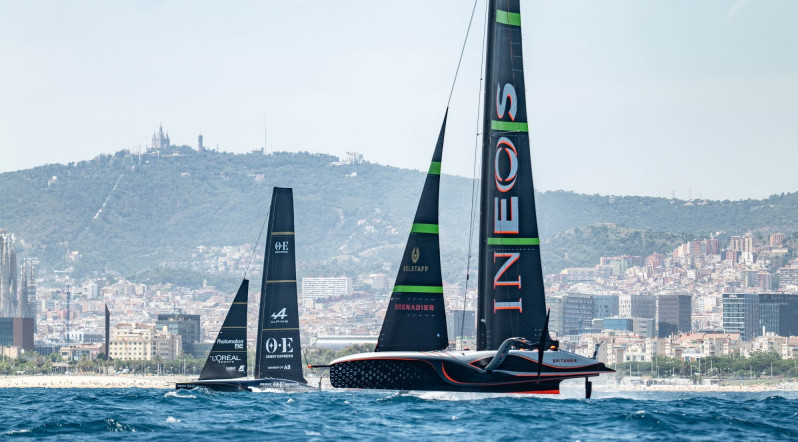
Asked about the unofficial line-up with Luna Rossa and later NYYC American Magic, Leigh added: “...it's always good to get little check ins and it just adds a bit more interest to the day when sailing near other boats but yeah it was a shame that that last one didn't work out, we had an unfortunate crash tack on that one and we were kind of planning on going in at that point anyway, the cyclors were totally spent by that point as well so I think that everyone was ready to hit the drop by that point.”
After four days in the shed, NYYC American Magic rolled out with all eyes on the appendages but nothing to see there just yet and all the upgrades being internal according to Tom Slingsby. It was a late session for the Americans who completed two hours in a steady 10-12 knots, concentrating on mark roundings and manoeuvres with a huge degree of success. The recon team noted a one-board round up at pace at a leeward gate as the icing on the cake.
Speaking afterwards Tom Slingsby gave his take on what success looks like in the bumpy conditions, saying: “I guess the manoeuvre success is a little bit tougher in those waves but you’re pretty much still tacking on your lay lines and gybing on your laylines and yeah overall I think we were able to execute manoeuvres well but the occasional one there when we didn't hook up out of the gybe for sure you lost a bit of distance.”
Slingsby is well into the detail of the AC75 technique and is focussing the team: “Honestly the stuff I want to work on is that little bit lighter winds and bump it's the toughest conditions to sail in pretty much any foiling boat and the conditions we’re expecting here in August, September is probably light airs and a bit of bump so that's what we would like to focus on a bit more.”
Asked about Patriot, as a boat, in comparison to the old AC36 warhorse, Tom said: “It's night and day, obviously nice big bustle sort of helps us go in and out and transition from displacement to foiling well, if we do make a mistake and fall off it feels like it's a short term thing and you just bustle ride and then get out of there and the old Patriot was pretty sticky and it was almost like if you did touchdown it was like it had glue on the bottom of it and was very hard to get going again, so this Patriot is going really well.”
The hard-driving Orient Express Racing Team were back for more today but had an unfortunate UFO strike on their legacy port foil late in the session that effectively curtailed their afternoon. Frustratingly for the French, the team had to stop a number of times for either electronic issues or jib sleeve issues with the J5 so it was another stop/start day punctuated by interesting flight times as the team continue their commissioning phase with this, their first ever AC75.
Quentin Delapierre was matter-of-fact in interview afterwards with a wonderfully calm approach saying: “We had an electronic issue so the boat just stopped and we just managed it, but all good and we were able to finish the sailing session so nothing too bad...just discovering the yacht in those conditions it was the first time for the whole team I mean quite impressed about how stable it is compared to the AC40 so super happy with what we saw in straight-lines upwind and downwind, we still have plenty of tasks to improve but yeah it was a really good feeling today.”
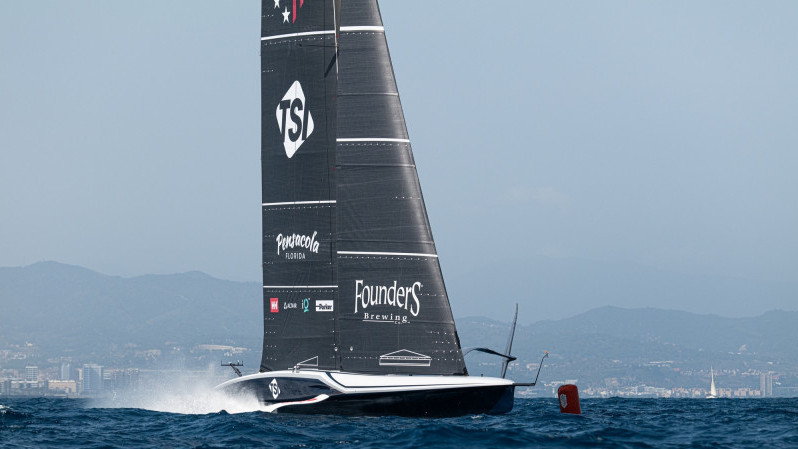
Quentin is clearly impressed with what the team are accomplishing, saying: “We're really confident, I mean super happy with what we have in the hands, the balance of the boat and the aero settings look really good, just waiting for the new foil on the port side, at the moment I'm handling the boat with the old generation so I can't wait to see the new design.” And asked about the focus from here on, he added: “Just reliability for the moment we are still in a commissioning period. I mean as a new team is a big focus for us to be reliable and just to push every department to be as reliable as we can.”
Great day on the water yet again for the four Challengers. It was a tough and uncompromising sea-way that challenged everyone. If we get conditions like this at the Louis Vuitton Cup it will be very interesting to see who emerges as the quickest. It’s going to be close, that’s a certainty. (Magnus Wheatley)
On-Water Recon Report – NYYC American Magic: After a four-day maintenance and upgrade break NYYC American Magic squeezed in a two-hour afternoon session today in 9-12 knot easterly winds with a nasty one metre plus steep chop sea-state.
The team rolled out on time at 1250 and had the boat rigged and launched by 1330. It was observed that the zippered cover system for the headsail had been refitted (see video below showing the cover in motion.) Dock-out time of 1528. Sails (M2-1 mainsail and J2-1 headsail were hoisted inside the harbour by 1550 with the boat exiting the harbour at 1557 where it popped straight on to the foils in bumpy conditions and 10 to 11 knots of wind from 090.
A long upwind followed during which the sea-state made it difficult for both the team chase boats and the recon boat to stay close to the American AC75. Despite the confused and unpredictable sea state, the yacht took off cleanly and smoothly and looked stable in flight and through manoeuvres.
After a long downwind the crew stopped at 1617 for a five-minute break before setting off again on a short free sailing windward/leeward lasting less than 10 minutes.
Following a 15-minute break the crew switched to practise racing with a pre-start and two lap windward / leeward around a laid course. Tacks and gybes and roundings looked smooth and accomplished and a fast one board leeward gate rounding was particularly impressive.
After a stop for a cyclor rotation and battery change the final session of the day saw the crew perform another practice start but the yacht turned downwind three quarters of the way up the first beat for a long fast downwind run to the harbour entrance.
The boat entered the harbour at 1740 where sails were quickly dropped with the boat arriving back at the dock at 1804.
On-Water Recon Report - INEOS Britannia: INEOS Britannia rolled out their AC75 at 10:00, with the R01 rudder. The LiDAR camera hardware remained in the same places, as well as the cameras on top of each foil wing. In addition, many GoPro cameras continue to be identified similarly. A pair under the spreaders, one on the transom looking down at the rudder and elevator, one on each rail and one on top of the rudder stock case looking to the front.
Britannia was craned to the water at 10:35 and the team docked-out at 12:00 as planned, after usual routine activities. The MN2-1 of smaller sail area was selected for today’s session, combined with the J4-1. Both sails were hoisted just before heading out of the harbour at 12:30 and were the only sails used during the day.
A very disorganized sea state from the ENE set the conditions for the day, combined with ENE winds varying from 14 to 9 knots of intensity, dropping towards the afternoon.
The training started at 12:35 just out of the harbour with an upwind warm-up, trying to cope with the tough sea state intending to achieve a stable boat. Once at the racecourse area, there was a short ten-minute break. Then INEOS engaged with LRPP, performing one long upwind-downwind with both boats sailing almost all the time on opposite tacks. Half-way on the downwind Britannia nose-dived on the second gybe, while failing to maintain stability.
No comparative performance conclusions could be achieved in such conditions, however, in general terms, LRPP seemed more stable and manoeuvring more comfortably in the difficult seas.
After a short break, at 13:30 Britannia resumed the session sailing on their own, performing two long upwinds and downwinds. It was really hard for all chase boats to be able to keep up with the AC75, and specially for us to achieve good quality content.
At 14:00 there was a twenty-minute new break in which there was a four-cyclors rotation, and two technicians got onboard and headed inside the front hatch.
The training continued at 14:20 with a short upwind-downwind-upwind, performing a few tacks and gybes. At the end of it, the technicians got onboard once more for twenty minutes to work inside the AC75. Once finished, at 15:00 one downwind was carried out towards the racecourse area, where one of the team’s chase boats had laid marks.
The first sequence got underway at 15:18, with INEOS starting right at the leeward end of the line, forced to make the pin. The start was followed by an upwind leg performing three tacks to round the top right mark, two gybes on the downwind before rounding the bottom left gate doing an early tack, followed by three more tacks to round the opposite top mark this time and two more gybes on the second downwind before rounding the opposite leeward gate.
After a short break a second sequence got started at 15:48, practicing once more to start right at the pin end and following up with a two-lap upwind-downwind executing three tacks and two gybes per leg.
Towards the end of the second downwind, Britannia tried to engage with NYYC American Magic who passed-by. However, shortly after starting, after a touchdown tack the comparison was abandoned and the British team headed back to the base.
The Team entered the harbour at 16:15. Sails were lowered inside the port, and the team docked at 16:45. The boat was craned out of the water thirty minutes after, indicating the end of the day. Sebastian Peri Brusa – Recon on INEOS Britannia
On-Water Recon Report – Orient Express Racing Team: Orient Express Racing Team began their preparation for the day at 08:00. With the yacht left out on the forecourt overnight with its rig on, the shore crew cleaned the hull and appendages with soap before craning in at 09:00. The yacht was then lifted above the water at foiling height, for FCS testing to be carried out, as the starboard foil was raised slightly, leaving just the inboard half of the foil submerged and the bulb just above the surface. Once lowered back in the water, hydraulics tests with cyclors in position were carried out, before working on the mainsheet system. Main traveller testing was observed before further aero system hydraulics tests were repeated.
The team docked out at 11:20, hoisting the M2-1 and J5-1, with a wind range between 14-20 knots measured off the breakwater, amid an aggressive sea state of waves measuring up to 1.5m and a short period of 3-4s. Sailing commenced just after midday, but electronic issues onboard stopped the boat. 45 minutes later, the team were able to take off, sailing a short stint of five minutes before coming to a stop to attend to an issue with the J5. Seemingly, the sleeve of the jib disconnected from the forestay, prompting the team to exchange for the J4-1.
Sailing resumed at 13:25, as the team sailed a short upwind, before a short break, then continuing on a long downwind stretch on port (foiling on the new foil). After another pause, the team set off upwind, completing three tacks, before bearing away downwind. The yacht suddenly came to a stop after hitting a floating object in the water, causing damage to the outboard surface of the port foil arm. Sails were dropped at 15:00 4NM offshore, and the yacht was towed back to base in displacement mode.
The team docked in at 16:00 after four and a half hours on the water, and 41 minutes of active sailing. 5 manoeuvres were performed, of which only two tacks were fully foiling. Quentin Delapierre confirmed the damage to the foil was not major, and the team is expected to sail again tomorrow. Justin Busuttil - AC Recon
On-Water Recon Report – Luna Rossa Prada Pirelli: Luna Rosa Prada Pirelli craned in the AC75 at 10:00 am this morning. Standard checks from the onshore team on different systems and controls were completed before the dock-out at 10:40.
LRPP paired their M1-7 mainsail with the J3-7 jib at 11:00 inside the harbour and started sailing just five minutes after. A wind of about 10 to 13 knots TWD 70º was blowing at that moment over short and steep waves of about 0.9 to 1.6 m from an easterly direction.
The sailing session today was basically divided in three different stints:
Stint 1 (11:05 to 12:55): 4 active upwinds and downwinds with 16 tacks and 13 gybes were drilled with mark roundings around virtual marks which were taken 50/50 port and starboard.
Stint 2 (12:55 to 14:50): 6 pre-starts in this stint. The first pre-start was followed by a two lap upwind-downwind course and the second pre-start was followed by a one lap upwind-downwind course. The other 4 starts were done with continuous timing, giving starts every 5 minutes. The goal from the last 4 starts seemed to be to nail the time on distance to the line and perform a quick tack just after crossing the line. The AC75 got into the box of the prestart 50% of the times in port side and 50% of the times in starboard side.
Stint 3 (15:00 to 15:15): On the way back to the harbour LRPP team set different virtual marks in short distances in all kinds of course directions and the AC75 had to round them in up or down direction and sometimes had to do a gybe or a tack to manage to get to the mark and round it.
To highlight:
Some criss-crosses done with INEOS from the beginning of the second lap after the first start they did. INEOS crossed first on the first 2 crosses and LRPP crossed in front INEOS on the last one.
When the wind was blowing stronger LRPP was securing tack and gybe manoeuvres, delaying lifting the new windward arm until the boat was feeling totally stable in the new course.
Mark roundings were done with both arms down mainly.
The following swaps were done:
Batteries were replaced at 14:30 (after 100 min of effective sailing)
Jib J3 was replaced for Jib J4 at 11:40 as wind increased to 14-18 knots TWD 70º at 11:40.
Jib J4 was replaced for Jib J3 at 13:40 as wind decreased to 11-14 knots TWD 70º at 13:40.
At the moment of the batteries swap we guess that two cyclor and one helm replacements were done.
Two long stops of 25 minutes were done for jib replacing and batteries replacement. Other few smaller stops were done also of about 10 minutes time each. Sails were dropped at 15:15 and the AC75 was towed back to base and dock in was at 16:45, after four hours and fifteen minutes on the course and 120 minutes of active sailing. 64 manoeuvres were observed at 90% fully foiling rate. Jose Luis Piñana – LRPP AC Recon



